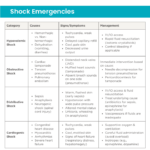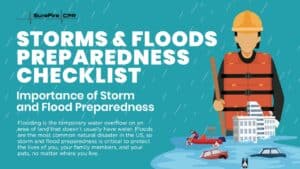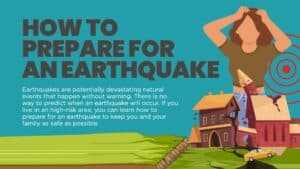Earthquakes are an ever-present danger in many areas across the U.S. and all over the world. At times predictable and at times unexpected, earthquakes can cause massive structural damage and pose serious safety risks to those near their epicenters. In the event of an earthquake, it’s essential to know the proper protocol to maximize your safety and the safety of those around you. This is especially true if you are a parent or a childcare professional, as you are in charge of teaching children what to do when an earthquake strikes. In this guide, our experts here at SureFire CPR will show you how with earthquake safety tips for children.
Below, we review proper earthquake safety protocol and outline several tips for teaching children both at home and in schools. Ensure that your children stay safe in the event of an earthquake with this comprehensive guide, and enroll in our safety certification courses for extra preparation ahead of any emergency.
First Steps: Familiarizing Yourself With Earthquakes and Earthquake Safety
Perhaps the most important step in teaching your children proper earthquake safety is first becoming proficient in earthquake safety protocol yourself. Without a solid foundation of knowledge, you will not be able to clearly teach children what to do in the event of an earthquake emergency. Before all else, building a solid foundation of earthquake safety knowledge begins with understandings what earthquakes are.
An earthquake is a natural disaster caused by the movement of earth’s tectonic plates at areas called faults. Though continuously moving, earth’s tectonic plates often get stuck on one another for years (if not centuries or millennia) at a time due to friction. Over time, stress builds up and eventually overcomes the friction between plates. At this moment, the plates become unstuck and a large amount of energy is released, causing an earthquake. The center of an earthquake, the point at which the plates become unstuck, is called the epicenter. Earthquakes can range in severity based on the amount of energy released and are measured on the Richter scale.
Staying safe during an earthquake involves understanding the many risks that earthquakes present and how to address each of them. If you are indoors during an earthquake, it’s important to drop to the ground, cover yourself by getting under a table or desk, put your arms over your head, and hold on to a secured object (like a table or desk leg) until the earthquake is over. This is called “drop, cover, and hold on.” If you are outdoors during an earthquake, seek open area away from buildings. It’s also important to assemble an emergency preparedness kit, create a building evacuation plan, and stay informed via regional apps or websites that can notify you of seismic activity. Learn how to put these preparation steps and more into practice in the following section.
Prepare Properly: Find Safe Spots, Stay Notified, and Keep Contact Information Current
After building a solid foundation in earthquake safety protocol, it’s time to put everything you learned into practice. This starts with a bit of hands-on preparation. Before teaching children what to do in the event of an earthquake, make sure to establish safe places in your home or school to go to should an earthquake strike, such as large, heavy tables or interior walls away from windows and bookshelves. It’s also important to create an evacuation plan (or familiarize yourself with your building’s existing evacuation routes) to facilitate fast and organized evacuation through the nearest exit in your building. You’ll also want to assemble an emergency preparedness kit with first aid materials such as bandages, antiseptic, a flashlight, a small supply of food and water, and an emergency cell phone. Consider taking a basic first aid or CPR & AED course to learn the ins and outs of administering emergency aid ahead of time.
After locating these materials and assembling the above items, you’ll want to make sure to have all of the right avenues of communication open. This starts by finding a place to get the most up-to-date earthquake alerts. We recommend getting the USGS’s Earthquake Notification Service on your phone for by-the-minute earthquake updates. You’ll also want to keep your local contact information current so you can notify neighbors, associates, and family of your location in the event of an earthquake emergency.
Comprehensive Earthquake Safety Tips: What to Do When an Earthquake Strikes
So far, this guide has touched on “drop, cover, and hold on” and reviewed earthquake preparation protocol. In this section, we apply these concepts to real-world earthquake scenarios. Here’s what to do when an earthquake strikes.
- Find an open area. Whether you are outdoors or indoors during an earthquake, move to find an open area free of anything that could fall on top of you. While it’s important to take cover indoors, if you are outdoors, the safest place you can be is in a wide-open area away from all other objects.
- If you’re in a vehicle, stop driving. Driving during an earthquake is a recipe for disaster — especially if you are in heavy traffic. The safest thing to do is to slow down as quickly as possible without causing an accident, make sure your seatbelt is fastened, and stop until the earthquake is over. Be sure to stop in an area with open sky above you. Large trees, buildings, overpasses, and tunnels can fall on top of you and cause serious injury or death, so avoid them whenever possible. Once the earthquake has concluded, proceed cautiously and avoid streets, bridges, and ramps that show signs of damage.
- DROP, COVER, and HOLD ON. By far the most important step to take in the event of an earthquake indoors, “drop, cover, and hold on” involves three steps. First, drop to the ground; next, take cover by getting under a sturdy table, desk, or alternate piece of furniture and putting your arms over your head; finally, hold on to the table, desk, or piece of furniture until the earthquake stops. If you cannot find any furniture nearby, crouch in an inside corner of the room you’re in and cover your head with your arms.
- Move away from buildings, utility wires, glass, or anything that could fall. No matter where you are when an earthquake strikes, it’s important to move away from objects that could fall on top of you. These include glass windows, building facades, signs, bookshelves, trees, and a host of other objects. Also, beware of utility wires and gas lines, both of which may break during an earthquake and cause extra harm to those nearby.
- If you are in debris, cover your mouth. If you happen to get stuck under debris during an earthquake, cover your mouth with your arms or your shirt to avoid contaminating your airways. Try not to move around excessively and kick up dust. Instead, tap on a nearby pipe or wall to alert rescuers to your location. If you have a whistle, blow it periodically. Try to avoid shouting, as this will cause you to inhale excessive quantities of dust and other hazardous airborne materials.
Talk to Your Children About Earthquakes and Earthquake Safety
Once you’ve learned about earthquakes and mastered earthquake safety for yourself, it’s time to teach what you know to the children in your life. If you are a parent, take the time to sit down with your kids and explain what earthquakes are to them. From there, you can begin to illustrate the dangers of an earthquake and how to stay safe should one strike. If you are a teacher, dedicate classroom time at least once a quarter to earthquake education and earthquake safety. Use visual aids and simple slogans like “drop, cover, and hold on” to convey safety tips clearly. Once you’ve done the educating, it’s time to start practicing.
Practice Earthquake Drills
Routinely practicing earthquake drills several times a year will familiarize children with what do in the event of an earthquake and will help reduce panic should one strike. Important concepts to cover include where to go (under desks, or near inside wall corners), what to do (drop, cover, and hold on), and where to move in the event of an evacuation (building evacuation routes). Practice each of these steps by running through them as though an earthquake were actually occurring. Cover each of the steps discussed in the sections above, and be sure to answer any questions your kids might have. If you are a parent, make sure your child’s school is routinely practicing earthquake drills with official evacuation plans to ensure that your child and his or her peers are safe.
Learn More About Earthquake Safety and Enroll in Safety Classes at SureFire CPR
Want to learn more about earthquake safety? Searching for extra earthquake safety teaching tips for kids? Our experts here at SureFire CPR have you covered. Contact us to speak with a member of our team directly and have all of your earthquake-related questions answered. Ready to take your safety skills to the next level? Enroll in one of our many in-person safety classes and online certification courses including Basic First Aid and CPR & AED Training to gain the skills necessary to maximize safety in any emergency. Enroll online with us today!











